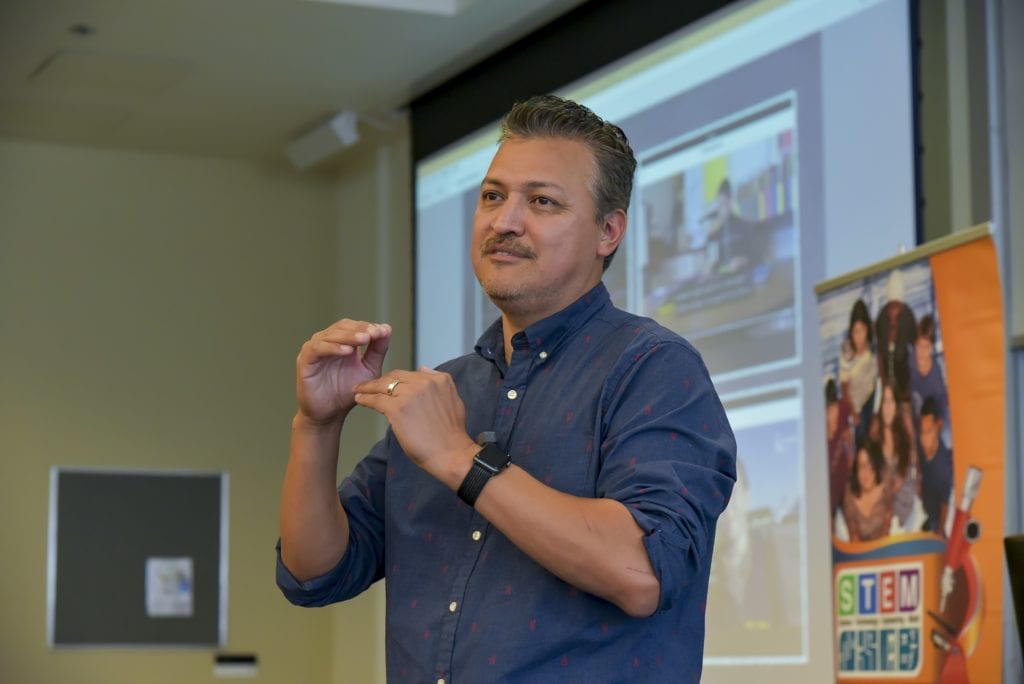Enrique Diaz’s journey from 6-year-old field worker to 46-year-old retired Apple engineer is a story fit for film. But for most of the Cal Poly graduate’s life, he didn’t realize the level of his accomplishment.
“I didn’t piece it together until I was about 40, thinking, ‘How did I get here?’” Diaz said.
Now 48, the Gilroy resident will discuss his journey from the Central Valley to Silicon Valley March 12 at 11 a.m. at the Advanced Technologies Laboratory. The presentation is part of the College of Engineering’s Diversity and Inclusion Speaker Series.
“Enrique’s story is inspiring for everyone,” said Eric Mehiel, associate dean for diversity and student success at Cal Poly’s College of Engineering. “But his achievements are especially encouraging for those who face significant obstacles and challenges due to factors beyond their control.”
Born in Mexico, 2-year-old Diaz came arrived in the United States with his 17-year-old mother in 1972. His father followed a year later. His mother had a sixth grade education, while his father had only made it to the third grade.
When Diaz was six, he began helping his parents in the fields, picking garlic.
“I don’t have bad memories of working in the field,” Diaz said. “I just wanted to help out.”
At times, living conditions were challenging, the family relying on food stamps and housing assistance to get by. And, as the years passed, Diaz worked different agricultural jobs, including irrigation duties, hoeing and weeding cotton and tomatoes, picking grapes, thinning lettuce and driving a tractor.
“Kids in our area would work,” he said, noting that 90 percent of his classmates were from Mexico. “It wasn’t a unique story.”
Growing up, Diaz’s dreams were simple.
“My goal was to work somewhere that had air conditioning,” he said.
When he was in the third grade, though, a teacher made a simple comment that would eventually have a profound impact on Diaz’s life.
“You’re pretty good at math,” she said. “You should consider being an engineer.’”
Diaz didn’t really know what an engineer did, but the comment stuck with him. And when he was thinking about college, he remembered those words. While he’d never had a computer, Diaz knew they were becoming increasingly important. (He bought his first computer – a Mac LCIII – on credit during his 4th year at Cal Poly.) So he decided to pursue computer engineering.
Cal Poly’s environment offered a stark contrast to his upbringing, but fellow students treated Diaz well, so the different backgrounds didn’t deter him.
“Naiveite played a big part in my life,” he said, comparing himself to the happily naïve fictional character Forrest Gump. “It became a shield – a super power.”
While working as a resident assistant at his dorm, Diaz met his future wife, Emily, a fellow RA and the daughter of Portuguese immigrants from the Azores.

After three internships with Hewlett Packard, Diaz went straight to Apple Computer (later Apple Inc.) after graduation while Emily became a high school English teacher.
As a research and development scientist, he was involved in the original Bondi blue iMac, the “Cube,” iPads , MacBook Pros, and more. In the mid-90s, Apple was a place for rapid innovation – and, for employees, long hours.
“It was a lot of late nights and weekends,” he said.
At 46, knowing that both his father and grandfather had died young, Diaz looked at his finances and decided to retire early.
“I got to a point where I was, like, ‘I think I have enough,’” he said.
Working at Apple allowed Diaz to buy his mother a home and offer support to other family members.
“It was a means of helping others – and it still is,” he said.
Today, Diaz, a father of two – including a son studying computer science at MIT — tries to give back, serving on the local school board, acting as the president of a charity and coaching basketball. He also acts as a public speaker, encouraging students to go to college.
“I went from working a lot for money to working a lot for no money,” he joked.
Jesse Gift, an Emmy Award-winning filmmaker, met Diaz while producing a documentary on a former field worker-turned-pediatrician. Now Gift has plans for Diaz’s story.
“We believe these are stories that must be heard and that mostly have never been told,” said Gift, whose Epic Indy produces film and speaking events. “We’re in development on several film iterations of Enrique’s story, including an animated film, a documentary and a scripted dramatic film.”
Diaz’s story does offer a nice story arc. After all, the boy who once loaded buckets of garlic now lives comfortably in the Garlic Capital of the World.
“I used to loathe garlic,” he said. “Now I love it.”


